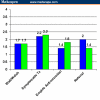How do clinicians manage vaginal complaints? An Internet survey
- PMID: 16369439
- PMCID: PMC1681596
How do clinicians manage vaginal complaints? An Internet survey
Abstract
Introduction: Although vaginal symptoms are among the most common presentations in primary care, little is known about how clinicians manage them.
Question: We undertook an Internet survey to determine how clinicians decided what was normal, how they evaluated vaginal complaints, and what happened when a diagnosis could not be reached.
Methods: A 27-question anonymous survey was conducted using the Medscape Internet publication platform and Medscape General Medicine , an online, peer-reviewed, open-access general medical journal. The study was targeted at physicians and nurse practitioners.
Results: There were 556 nurse practitioner and 608 physician respondents. Clinicians generally agreed that a midcycle increase in discharge and discharge seen at the introitus were normal; itching/irritation, odor, and a green discharge were not. There was less agreement concerning the value of a yellow discharge and "self-diagnosis" of abnormality. Eighty-two percent of MDs and 77% of NPs reported examining patients prior to treatment always or often. Only about 30% performed pH testing always or often. Ninety percent of NPs and 92% of MDs reported not making a diagnosis rarely or sometimes. When offered 4 different management strategies for patients in whom no diagnosis was made (watch and wait, symptomatic therapy, empiric antibiotics, referral), there was no clear preference. There was a weak correlation between performance of a wet mount and reports of less non-diagnosis. There was no correlation between pH and whiff testing and reports of less non-diagnosis.
Conclusions: Clinicians do not always agree about what constitutes a vaginal symptom. Although most providers usually examine patients with vaginal complaints, pH and whiff testing are performed less frequently. Our data suggest the latter 2 maneuvers are not diagnostically helpful. There is no consensus regarding what to do when no diagnosis is made. Our findings suggest that the traditional approach to the evaluation of vaginal symptoms may have limited relevance for clinicians.
Figures



References
-
- Mou S. Vulvovaginitis. In: Rakel RE, Bope ET, editors. Conn's Current Therapy 2003. Philadelphia, Pa: Saunders; 2003. pp. 1149–1152.
-
- Mulley AG. Approach to the patient with a vaginal discharge. In: Goroll AH, Mulley AG, editors. Primary Care Medicine: Office Evaluation and Management of the Adult Patient. Philadelphia, Pa: Lippincott, Williams & Wilkins; 2000. pp. 702–707.
-
- Washington, DC: American College of Obstetricians and Gynecologists; 1996. Anonymous. Technical Bulletin No. 226 Vaginitis.
-
- Coco AS, Vandenbosche M. Infectious vaginitis. An accurate diagnosis is essential and attainable. Postgrad Med. 2000;107:63–74. - PubMed
MeSH terms
LinkOut - more resources
Full Text Sources
Medical
Research Materials
Miscellaneous

